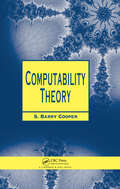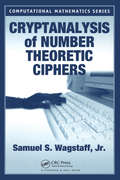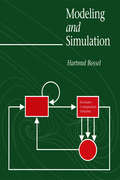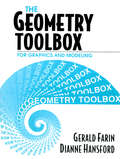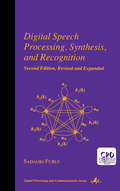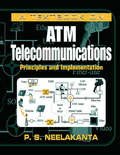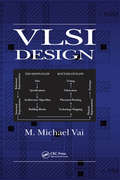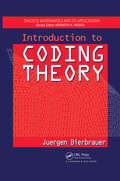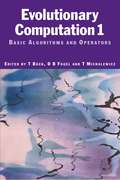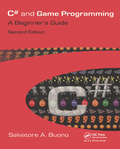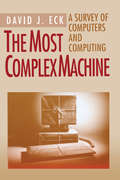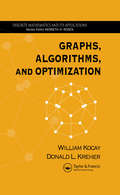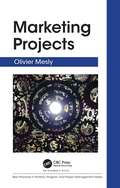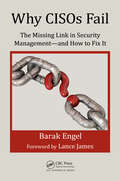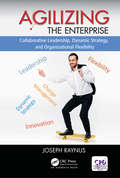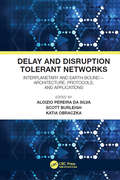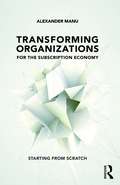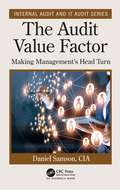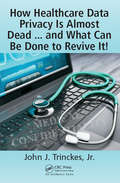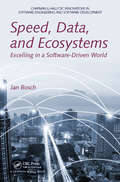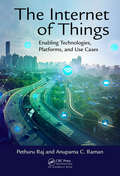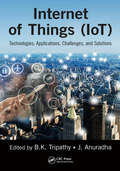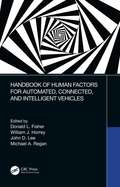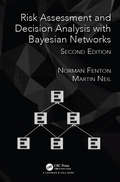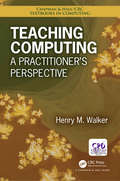- Table View
- List View
Computability Theory: Journeys Beyond The Turing Barrier (Chapman Hall/CRC Mathematics Series)
by S. Barry Cooper<p>Computability theory originated with the seminal work of Gödel, Church, Turing, Kleene and Post in the 1930s. This theory includes a wide spectrum of topics, such as the theory of reducibilities and their degree structures, computably enumerable sets and their automorphisms, and subrecursive hierarchy classifications. Recent work in computability theory has focused on Turing definability and promises to have far-reaching mathematical, scientific, and philosophical consequences. <p>Written by a leading researcher, Computability Theory provides a concise, comprehensive, and authoritative introduction to contemporary computability theory, techniques, and results. The basic concepts and techniques of computability theory are placed in their historical, philosophical and logical context. This presentation is characterized by an unusual breadth of coverage and the inclusion of advanced topics not to be found elsewhere in the literature at this level.The book includes both the standard material for a first course in computability and more advanced looks at degree structures, forcing, priority methods, and determinacy. The final chapter explores a variety of computability applications to mathematics and science. <p>Computability Theory is an invaluable text, reference, and guide to the direction of current research in the field. Nowhere else will you find the techniques and results of this beautiful and basic subject brought alive in such an approachable and lively way.</p>
Cryptanalysis of Number Theoretic Ciphers (Computational Mathematics)
by Samuel S. Wagstaff, Jr.At the heart of modern cryptographic algorithms lies computational number theory. Whether you're encrypting or decrypting ciphers, a solid background in number theory is essential for success. Written by a number theorist and practicing cryptographer, Cryptanalysis of Number Theoretic Ciphers takes you from basic number theory to the inner workings of ciphers and protocols.First, the book provides the mathematical background needed in cryptography as well as definitions and simple examples from cryptography. It includes summaries of elementary number theory and group theory, as well as common methods of finding or constructing large random primes, factoring large integers, and computing discrete logarithms. Next, it describes a selection of cryptographic algorithms, most of which use number theory. Finally, the book presents methods of attack on the cryptographic algorithms and assesses their effectiveness. For each attack method the author lists the systems it applies to and tells how they may be broken with it.Computational number theorists are some of the most successful cryptanalysts against public key systems. Cryptanalysis of Number Theoretic Ciphers builds a solid foundation in number theory and shows you how to apply it not only when breaking ciphers, but also when designing ones that are difficult to break.
Modeling and Simulation: Stochastic And Control Systems, Pattern Recognition, Fuzzy Analysis, Simulation, Behavioral Models (Interdisciplinary Systems Research Ser.)
by Hartmut BosselModels and simulations of all kinds are tools for dealing with reality. Humans have always used mental models to better understand the world around them: to make plans, to consider different possibilities, to share ideas with others, to test changes, and to determine whether or not the development of an idea is feasible. The book Modeling and Simulation uses exactly the same approach except that the traditional mental model is translated into a computer model, and the simulations of alternative outcomes under varying conditions are programmed on the computer. The advantage of this method is that the computer can track the multitude of implications and consequences in complex relationships much more quickly and reliably than the human mind. This unique interdisciplinary text not only provides a self contained and complete guide to the methods and mathematical background of modeling and simulation software (SIMPAS) and a collection of 50 systems models on an accompanying diskette. Students from fields as diverse as ecology and economics will find this clear interactive package an instructive and engaging guide.
The Geometry Toolbox for Graphics and Modeling
by Gerald Farin Dianne HansfordThe Geometry Toolbox takes a novel and particularly visual approach to teaching the basic concepts of two- and three-dimensional geometry. It explains the geometry essential for today's computer modeling, computer graphics, and animation systems. While the basic theory is completely covered, the emphasis of the book is not on abstract proofs but rather on examples and algorithms. The Geometry Toolbox is the ideal text for professionals who want to get acquainted with the latest geometric tools. The chapters on basic curves and surfaces form an ideal stepping stone into the world of graphics and modeling. It is also a unique textbook for a modern introduction to linear algebra and matrix theory.
Digital Speech Processing, Synthesis, and Recognition: Synthesis, and Recognition, Second Edition, (Signal Processing and Communications #7)
by Sadaoki FuruiA study of digital speech processing, synthesis and recognition. This second edition contains new sections on the international standardization of robust and flexible speech coding techniques, waveform unit concatenation-based speech synthesis, large vocabulary continuous-speech recognition based on statistical pattern recognition, and more.
A Textbook on ATM Telecommunications: Principles and Implementation
by P. S. NeelakantaWith quantum leaps in science and technology occurring at breakneck speed, professionals in virtually every field face a daunting task-practicing their discipline while keeping abreast of new advances and applications in their filed. In no field is this more applicable than in the rapidly growing field of telecommunications engineering. Practicing engineers who work with ATM technology on a daily basis must not only keep their skill sharp in areas such as ATM network interfaces, protocols, and standards, but they must also stay informed, about new classes of ATM applications.A Textbook on ATM Telecommunications gives active telecommunications engineers the advantage they need to stay sharp in their field. From the very basics of ATM to state-of-the-art applications, it covers the gamut of topics related to this intriguing switching and multiplexing strategy. Starting with an introduction to telecommunications, this text combines the theory underlying broadband communications technology with applied practical instruction and lessons gleaned from industry. The author covers fundamental communications and network theory, followed by applied ATM networking. Each chapter includes design exercises as well as worked examples .A Textbook on ATM Telecommunications includes examples of design and implementation-making it an ideal took for both aspiring and practicing telecommunication professionals.Features
VLSI Design (VLSI Circuits #1)
by M. Michael VaiVery Large Scale Integration (VLSI) has become a necessity rather than a specialization for electrical and computer engineers. This unique text provides Engineering and Computer Science students with a comprehensive study of the subject, covering VLSI from basic design techniques to working principles of physical design automation tools to leading edge application-specific array processors.Beginning with CMOS design, the author describes VLSI design from the viewpoint of a digital circuit engineer. He develops physical pictures for CMOS circuits and demonstrates the top-down design methodology using two design projects - a microprocessor and a field programmable gate array. The author then discusses VLSI testing and dedicates an entire chapter to the working principles, strengths, and weaknesses of ubiquitous physical design tools. Finally, he unveils the frontiers of VLSI. He emphasizes its use as a tool to develop innovative algorithms and architecture to solve previously intractable problems.VLSI Design answers not only the question of "what is VLSI," but also shows how to use VLSI. It provides graduate and upper level undergraduate students with a complete and congregated view of VLSI engineering.
Introduction to Coding Theory (Discrete Mathematics and Its Applications #5)
by Jurgen BierbrauerAlthough its roots lie in information theory, the applications of coding theory now extend to statistics, cryptography, and many areas of pure mathematics, as well as pervading large parts of theoretical computer science, from universal hashing to numerical integration.Introduction to Coding Theory introduces the theory of error-correcting codes in a thorough but gentle presentation. Part I begins with basic concepts, then builds from binary linear codes and Reed-Solomon codes to universal hashing, asymptotic results, and 3-dimensional codes. Part II emphasizes cyclic codes, applications, and the geometric desciption of codes. The author takes a unique, more natural approach to cyclic codes that is not couched in ring theory but by virtue of its simplicity, leads to far-reaching generalizations. Throughout the book, his discussions are packed with applications that include, but reach well beyond, data transmission, with each one introduced as soon as the codes are developed.Although designed as an undergraduate text with myriad exercises, lists of key topics, and chapter summaries, Introduction to Coding Theory explores enough advanced topics to hold equal value as a graduate text and professional reference. Mastering the contents of this book brings a complete understanding of the theory of cyclic codes, including their various applications and the Euclidean algorithm decoding of BCH-codes, and carries readers to the level of the most recent research.
Evolutionary Computation 1: Basic Algorithms and Operators (Ieee Press Series On Computational Intelligence Ser. #1)
by Thomas Baeck D. B Fogel Z MichalewiczThe field of evolutionary computation is expanding dramatically, fueled by the vast investment that reflects the value of applying its techniques. Culling material from the Handbook of Evolutionary Computation, Evolutionary Computation 1: Basic Algorithms and Operators contains up-to-date information on algorithms and operators used in evolutionary computing. This volume discusses the basic ideas that underlie the main paradigms of evolutionary algorithms, evolution strategies, evolutionary programming, and genetic programming. It is intended to be used by individual researchers, teachers, and students working and studying in this expanding field.
C# and Game Programming: A Beginner's Guide
by Salvatore A. BuonoThe second edition of C# and Game Programming offers the same practical, hands-on approach as the first edition to learning the C# language through classic arcade game applications. Complete source code for games like Battle Bit, Asteroid Miner, and Battle Tennis, included on the CD-ROM, demonstrates programming strategies and complements the comprehensive treatment of C# in the text. From the basics of adding graphics and sound to games, to advanced concepts such as the .Net framework and object-oriented programming, this book provides the foundations for a beginner to become a full-fledged programmer. New in this edition: - Supports DirectX 9.0 - Revised programs and examples - Improved frame rate for game examples
The Most Complex Machine: A Survey of Computers and Computing
by David J. EckThis introduction to computers presents the fundamental ideas and principles on which modern computers are built. While used as a text for courses in computer appreciation as well as introductions to computer science, the book has found a wide audience among computer users who wish to understand the basis of the machines that form and transform our society.What Computers Do • Teaching Silicon to Compute • Building a Computer •†Theoretical Computers • Real Computers • Programming • Subroutines and Recursion • Real Programming Languages • Applications • Cooperating Computers • Graphics • Artificial Intelligence • Answers • The text is supplemented by a web site that gives access to other problems and projects.
Graphs, Algorithms, and Optimization (Discrete Mathematics and Its Applications)
by William Kocay Donald L. Kreher<p>Graph theory offers a rich source of problems and techniques for programming and data structure development, as well as for understanding computing theory, including NP-Completeness and polynomial reduction. A comprehensive text, Graphs, Algorithms, and Optimization features clear exposition on modern algorithmic graph theory presented in a rigorous yet approachable way. The book covers major areas of graph theory including discrete optimization and its connection to graph algorithms. The authors explore surface topology from an intuitive point of view and include detailed discussions on linear programming that emphasize graph theory problems useful in mathematics and computer science. Many algorithms are provided along with the data structure needed to program the algorithms efficiently. <p>The book also provides coverage on algorithm complexity and efficiency, NP-completeness, linear optimization, and linear programming and its relationship to graph algorithms.Written in an accessible and informal style, this work covers nearly all areas of graph theory. Graphs, Algorithms, and Optimization provides a modern discussion of graph theory applicable to mathematics, computer science, and crossover applications.</p>
Marketing Projects (Best Practices in Portfolio, Program, and Project Management)
by Olivier MeslyMarketing is about placing a new product or service into the market. Projects are about delivering new products and services. The merger of these two fields holds great promise for delivering value to organizations and their clients. Project managers can serve many markets ranging from investors who fund projects to that of clients who use new products and services. Marketing Projects is a guide for helping project managers have projects funded or deliver value to end users. It is also a guide for marketing managers new to the world of project management. The book begins by presenting the basics of both marketing and project management and highlights the aspects that are unique and relevant to both areas. It then explores marketing project feasibility and presents tools for assessing feasibility, which include the 6Ps of project management strategy: The project 4Ps: plan, processes, people, and power PRO: pessimistic, realistic, and optimistic scenarios POVs: points of vulnerability POE: point of equilibrium POW: product, organization, and work breakdown structures PWP: work psychodynamics This book illustrates how to use these tools to market new projects to potential sponsors and investors. It then explores marketing projects to end users. Crucial to the success of projects are the relationships between project managers and clients and the way marketing experts implement their strategies. This book explains how project managers can develop meaningful relationships with clients to foster trust and have positive interactions. Project managers excel at managing the processes for delivering new products and services. Marketers are keenly aware of latent, or unconscious needs, as well as those developing and emerging, and can provide project promoters and managers with exciting ideas. This book will help improve the mutual understanding between marketing and project managers, an effort ultimately benefiting end users, whether they be investors or customers. A better work atmosphere and a closer fit between marketing and project management objectives can only serve the interests of investors and end users, for whom marketers and project managers conceive and realize projects, one way or the other.
Why CISOs Fail: The Missing Link in Security Management--and How to Fix It (Internal Audit and IT Audit)
by Barak EngelThis book serves as an introduction into the world of security and provides insight into why and how current security management practices fail, resulting in overall dissatisfaction by practitioners and lack of success in the corporate environment. The author examines the reasons and suggests how to fix them. The resulting improvement is highly beneficial to any corporation that chooses to pursue this approach or strategy and from a bottom-line and business operations perspective, not just in technical operations. This book transforms the understanding of the role of the CISO, the selection process for a CISO, and the financial impact that security plays in any organization.
Agilizing the Enterprise
by Joseph RaynusAre you still searching for the workplace that deserves someone like you? Do you really have a good understanding about what is going on out there, in the business world? In this book, we will discuss the importance of agility and how it affects the solutions that are being delivered by an organization. We will also talk about how a blend of strategic innovation, visionary leadership, and organizational agility go hand in hand to ensure the success of an organization. Enterprise agility is not a far-fetched possibility. Once the problems of the organization are identified, with the right tools and effort, the agility, efficiency, and effectiveness of an organization, as well as the processes that the success of the organization are based on, can all be maximized. This book will broaden your thinking and will help you expand your horizons.
Delay and Disruption Tolerant Networks: Interplanetary and Earth-Bound -- Architecture, Protocols, and Applications
by Aloizio Pereira da Silva, Scott Burleigh and Katia ObraczkaDelay- and Disruption Tolerant Networks (DTNs) are networks subject to arbitrarily long-lived disruptions in connectivity and therefore cannot guarantee end-to-end connectivity at all times. Consequently DTNs called for novel core networking protocols since most existing Internet protocols rely on the network’s ability to maintain end-to-end communication between participating nodes. This book presents the fundamental principles that underline DTNs. It explains the state-of-the-art on DTNs, their architecture, protocols, and applications. It also explores DTN’s future technological trends and applications. Its main goal is to serve as a reference for researchers and practitioners.
Transforming Organizations for the Subscription Economy: Starting from Scratch
by Alexander ManuThe emerging present is a fast-changing context for incumbent organizations, especially in market segments where online behavior is replacing physical proximity, and users engage with digital platforms for the acquisition of products and services. These are platforms that allow users to behave, to leave a mark, and to participate in the community of others, which are the values people now seek. Transforming Organizations for the Subscription Economy: Starting from Scratch aims to prepare executives for a world in which everything is social, augmented and autonomous; objects and spaces will have multiple purposes, capabilities and meanings. This is a new territory full of opportunity which is generally discussed only at the level of technology involved instead of the intellectual level, where the real understanding of the need for transformation resides. The book reveals ideas about what is possible if we transform the present. The narrative is organized around what is actual and what is potential; what is the probable future that we can arrive at through change, and what is the possible future that we can build through transformation. When engaging in transformation, the following strategic question develops: if you were designing your organization today, how would you design it? In other words, how would you go about it starting from scratch? This book provides the intellectual framework that empowers organizations to understand and navigate the emerging present, and to develop and deliver products and services of intrinsic value to users.
The Audit Value Factor (Internal Audit and IT Audit)
by Daniel SamsonThe Audit Value Factor: Making Management’s Head Turn empowers readers with a systematic method to build and maintain a value-centric internal audit organization. The book explores how to identify, quantify, and articulate value for customers. It details six critical success factors: Value propositions that link directly to customer needs Fostering customer relationships using the CREATE model Talent development using the TEAM model Risk expertise that raises awareness, understanding, and action Change management and process optimization using the SMART model Data analytics that provide powerful insights to operations The Audit Value Factor offers easy to use tools and practical strategies that deliver tangible and immediate benefits for the internal audit team. Praise for The Audit Value Factor: Making Management’s Head Turn "Daniel Samson, the inspiring and forward-thinking CAE at SRI International, has created an essential guide to adding value through Internal Audit in his new book The Audit Value Factor. It's an important addition to any internal auditor's toolkit, with helpful suggestions on topics ranging from talent planning to data analytics. I highly recommend it to any internal audit professional looking to "up their game." Laurie A. Hanover, CIA, CAE Sunrun Inc. "Internal Auditors often strive for a ‘seat at the table,’ be it with Business Leaders, Senior Management, the Board, or really, any significant decision maker in an organization. In The Audit Value Factor, Dan Samson provides the roadmap to ensuring that Internal Audit gets not only that seat at the table, but also that role of a critical business partner that is valued in facilitating change and helping an organization achieve its goals." Brian Tremblay, CAE Acacia Communications "Great audit functions generate value and build leadership capacity from staff to CAE. The Audit Value Factor’s compelling examples, data, and actionable tools enable auditors at every level to build relationships of trust, ask the right questions, and deliver powerful insights to their organization." Dr. Kathryn Bingham, Executive Coach and CEO, LEADistics LLC
How Healthcare Data Privacy Is Almost Dead ... and What Can Be Done to Revive It!
by John J. Trinckes, Jr.The healthcare industry is under privacy attack. The book discusses the issues from the healthcare organization and individual perspectives. Someone hacking into a medical device and changing it is life-threatening. Personal information is available on the black market. And there are increased medical costs, erroneous medical record data that could lead to wrong diagnoses, insurance companies or the government data-mining healthcare information to formulate a medical ‘FICO’ score that could lead to increased insurance costs or restrictions of insurance. Experts discuss these issues and provide solutions and recommendations so that we can change course before a Healthcare Armageddon occurs.
Speed, Data, and Ecosystems: Excelling in a Software-Driven World (Chapman & Hall/CRC Innovations in Software Engineering and Software Development Series)
by Jan BoschAs software R&D investment increases, the benefits from short feedback cycles using technologies such as continuous deployment, experimentation-based development, and multidisciplinary teams require a fundamentally different strategy and process. This book will cover the three overall challenges that companies are grappling with: speed, data and ecosystems. Speed deals with shortening the cycle time in R&D. Data deals with increasing the use of and benefit from the massive amounts of data that companies collect. Ecosystems address the transition of companies from being internally focused to being ecosystem oriented by analyzing what the company is uniquely good at and where it adds value.
The Internet of Things: Enabling Technologies, Platforms, and Use Cases
by Pethuru Raj Anupama C. RamanAs more and more devices become interconnected through the Internet of Things (IoT), there is an even greater need for this book,which explains the technology, the internetworking, and applications that are making IoT an everyday reality. The book begins with a discussion of IoT "ecosystems" and the technology that enables them, which includes: Wireless Infrastructure and Service Discovery Protocols Integration Technologies and Tools Application and Analytics Enablement Platforms A chapter on next-generation cloud infrastructure explains hosting IoT platforms and applications. A chapter on data analytics throws light on IoT data collection, storage, translation, real-time processing, mining, and analysis, all of which can yield actionable insights from the data collected by IoT applications. There is also a chapter on edge/fog computing. The second half of the book presents various IoT ecosystem use cases. One chapter discusses smart airports and highlights the role of IoT integration. It explains how mobile devices, mobile technology, wearables, RFID sensors, and beacons work together as the core technologies of a smart airport. Integrating these components into the airport ecosystem is examined in detail, and use cases and real-life examples illustrate this IoT ecosystem in operation. Another in-depth look is on envisioning smart healthcare systems in a connected world. This chapter focuses on the requirements, promising applications, and roles of cloud computing and data analytics. The book also examines smart homes, smart cities, and smart governments. The book concludes with a chapter on IoT security and privacy. This chapter examines the emerging security and privacy requirements of IoT environments. The security issues and an assortment of surmounting techniques and best practices are also discussed in this chapter.
Internet of Things (IoT): Technologies, Applications, Challenges and Solutions
by B. K. Tripathy J. AnuradhaThe term IoT, which was first proposed by Kevin Ashton, a British technologist, in 1999 has the potential to impact everything from new product opportunities to shop floor optimization to factory worker efficiency gains, that will power top-line and bottom-line gains. As IoT technology is being put to diversified use, the current technology needs to be improved to enhance privacy and built secure devices by adopting a security-focused approach, reducing the amount of data collected, increasing transparency and providing consumers with a choice to opt out. Therefore, the current volume has been compiled, in an effort to draw the various issues in IoT, challenges faced and existing solutions so far. Key Points: • Provides an overview of basic concepts and technologies of IoT with communication technologies ranging from 4G to 5G and its architecture. • Discusses recent security and privacy studies and social behavior of human beings over IoT. • Covers the issues related to sensors, business model, principles, paradigms, green IoT and solutions to handle relevant challenges. • Presents the readers with practical ideas of using IoT, how it deals with human dynamics, the ecosystem, the social objects and their relation. • Deals with the challenges involved in surpassing diversified architecture, protocol, communications, integrity and security.
Handbook of Human Factors for Automated, Connected, and Intelligent Vehicles
by Donald L. Fisher William J. Horrey John D. Lee Michael A. ReganHandbook of Human Factors for Automated, Connected, and Intelligent Vehicles Subject Guide: Ergonomics & Human Factors Automobile crashes are the seventh leading cause of death worldwide, resulting in over 1.25 million deaths yearly. Automated, connected, and intelligent vehicles have the potential to reduce crashes significantly, while also reducing congestion, carbon emissions, and increasing accessibility. However, the transition could take decades. This new handbook serves a diverse community of stakeholders, including human factors researchers, transportation engineers, regulatory agencies, automobile manufacturers, fleet operators, driving instructors, vulnerable road users, and special populations. It provides information about the human driver, other road users, and human–automation interaction in a single, integrated compendium in order to ensure that automated, connected, and intelligent vehicles reach their full potential. Features Addresses four major transportation challenges—crashes, congestion, carbon emissions, and accessibility—from a human factors perspective Discusses the role of the human operator relevant to the design, regulation, and evaluation of automated, connected, and intelligent vehicles Offers a broad treatment of the critical issues and technological advances for the designing of transportation systems with the driver in mind Presents an understanding of the human factors issues that are central to the public acceptance of these automated, connected, and intelligent vehicles Leverages lessons from other domains in understanding human interactions with automation Sets the stage for future research by defining the space of unexplored questions
Risk Assessment and Decision Analysis with Bayesian Networks
by Norman Fenton Martin NeilSince the first edition of this book published, Bayesian networks have become even more important for applications in a vast array of fields. This second edition includes new material on influence diagrams, learning from data, value of information, cybersecurity, debunking bad statistics, and much more. Focusing on practical real-world problem-solving and model building, as opposed to algorithms and theory, it explains how to incorporate knowledge with data to develop and use (Bayesian) causal models of risk that provide more powerful insights and better decision making than is possible from purely data-driven solutions. Features Provides all tools necessary to build and run realistic Bayesian network models Supplies extensive example models based on real risk assessment problems in a wide range of application domains provided; for example, finance, safety, systems reliability, law, forensics, cybersecurity and more Introduces all necessary mathematics, probability, and statistics as needed Establishes the basics of probability, risk, and building and using Bayesian network models, before going into the detailed applications A dedicated website contains exercises and worked solutions for all chapters along with numerous other resources. The AgenaRisk software contains a model library with executable versions of all of the models in the book. Lecture slides are freely available to accredited academic teachers adopting the book on their course.
Teaching Computing: A Practitioner's Perspective
by Henry M. WalkerTeaching can be intimidating for beginning faculty. Some graduate schools and some computing faculty provide guidance and mentoring, but many do not. Often, a new faculty member is assigned to teach a course, with little guidance, input, or feedback. Teaching Computing: A Practitioner’s Perspective addresses such challenges by providing a solid resource for both new and experienced computing faculty. The book serves as a practical, easy-to-use resource, covering a wide range of topics in a collection of focused down-to-earth chapters. Based on the authors’ extensive teaching experience and his teaching-oriented columns that span 20 years, and informed by computing-education research, the book provides numerous elements that are designed to connect with teaching practitioners, including: A wide range of teaching topics and basic elements of teaching, including tips and techniques Practical tone; the book serves as a down-to-earth practitioners’ guide Short, focused chapters Coherent and convenient organization Mix of general educational perspectives and computing-specific elements Connections between teaching in general and teaching computing Both historical and contemporary perspectives This book presents practical approaches, tips, and techniques that provide a strong starting place for new computing faculty and perspectives for reflection by seasoned faculty wishing to freshen their own teaching.
